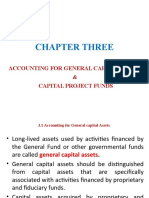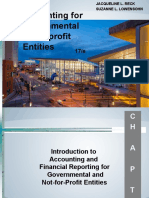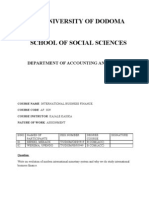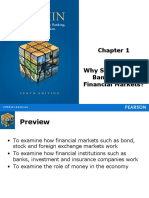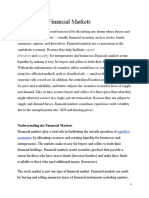Chapter 1
Uploaded by
xyzChapter 1
Uploaded by
xyzFinancial Institutions , Markets & Money FIN 221
Chapter 1 Summary Prepared By Al Mannaei
The Role of Financial System
The financial system consists of:
1. Financial Market: Consists of two sides represent buyers (demand) and sellers (supply)
of financial instruments also called financial claims or securities (stocks, bonds, future
contracts, mortgage ) . ex. of financial market ( Bahrain stock exchange New York
stock Exchange (NYSE) ). To simplify the definition its a market for financial claims .
2. Financial Institutions (financial intermediaries): facilitate the flow of funds from
savers ( SSU , lenders , investors ) to borrowers. Such as Commercial banks, credit
unions, life insurance companies and finance companies. ex of financial institution (
Bahrain Islamic Bank (BISB) , Kuwait Finance House (KFH) , Takaful Insurance .
Budget Position:
1. A balanced Budget Position ( Income = expenditures)
2. SSU : a Surplus Spending Unit - Position ( income > expenditures)
-
SSUs have income for the period that exceeds spending, resulting in savings. Other
words for SSU are saver, lender, or investor. Most SSUs are households.
3. DSU : a Deficit Spending Unit - Position ( income < expenditures )
-
DSUs have spending for the period that exceeds income. Another word for DSU is
borrower. Most DSUs are businesses or governments.
Note : Any Unit ( Households , Business Firm & Government ) can be SSU or DSU ,
BUT usually the household represent SSU , and the Business firm & Governments
represent DSU .
Financial Institutions , Markets & Money FIN 221
Chapter 1 Summary Prepared By Al Mannaei
Economic Units:
1. Households: Budget Surplus (income , consumption , real investment expenditures)
2. Business firms: Budget constraint ( limited ) : Borrow from SSU in order to expand their
business ( ex. building new factory )
3. Governments (local , state and federal): Budget constraint (limited) : Borrow from SSU
in order to finance infrastructure projects ( building schools , roads etc)
Financial Claims : it also called IOU1 , Financial instruments , securities . Its a promise
to pay .The issuer of IOU or the financial claim (ex. government , corporation ) promise to the
buyer that he will pay back the borrowed money with interest. There are three component of
the financial claims : the principle ( the amount of money ) , interest or fees And the maturity (
when the borrower must return the principle to the buyer )
IOU for DSU is a liability and its an asset for SSU. The financial system balancestotal financial assets equal total liabilities.
The ease with which a financial claim can be resold is called marketability.
Direct & Indirect Financing : Regardless of the financing methods the goal is to bring the
parties ( SSU & DSU ) together at least possible cost which is called operational
efficiency.
1- Direct financing : Where the SSU & DSU exchange money and financial claims
directly using direct claims.
a- Private Placement : DSU sells whole security issue to one investor or investor
group.
b- Brokers & Dealers2 :
IOU I owe you If Ali said to Hassan : I owe you 300 BD , it mean that Ali have to pay to Hassan 300 BD.
Although dealers & brokers play the middleman role , the finance will consider direct as the financial claims
feature ( amount , risk , liquidity , maturity ) will not changed .
2
Financial Institutions , Markets & Money FIN 221
Chapter 1 Summary Prepared By Al Mannaei
o Brokers : Bring SSU & DSU together maker, Broker make profit from
commission fee . Note that the broker will not own the financial claims.
o Dealers : Buy the financial claims at bid price from DSU and resell it to SSU
at ask price , the dealer will make profit from Ask-Bid spread , dealers will
make profit as long as Ask price if above bid price, the dealers called Market
maker because they affect the market price. Dealers are taking higher amount
of risk as they own the securities before reselling it to the SSU.
c- Investment Bank : Buy entire issues of securities from DSUs then find SSUs to
buy securities at higher price , Investment bank profit from difference underwriting spread.
For all the three categories of direct finance, in case of default 3 the SSU have to refer
to the DSU (the issuer of the financial claims) , WHY ?! because the direct financial
claims is guaranteed by the DSU ( issuer ) not by the dealers , broker or investment
bank.
Test Your Knowledge : True & False
When an SSU owns a financial claim created by financial intermediation, its residual
claim is against a DSU. ( )
False , Why ?! Because the financial intermediation will buy direct financial claims and
issue indirect financial claims , therefore the SSU will claim against the financial
intermediation not the DSU.
Advantages of Direct Financing
o Speed & low cost of the transaction as its one big transaction .
Disadvantages of Direct Financing
1- The amount (denomination) of the direct financial claims is very large , making it
hard to find another party to make the deal.
Default : Unable to repay their debt ( loans , bonds..etc)
Financial Institutions , Markets & Money FIN 221
Chapter 1 Summary Prepared By Al Mannaei
2- SSU & DSU should have the same preference of maturity , risk & liquidity .If the
preference not match the bargain (deal) will not be done.
Indirect Financing :
Due to the problems of Direct financing , for example the transaction amount (
denomination) are very large , also DSU must find SSU that want direct claims
with precisely ( exactly ) the characteristics or features ( Return , Risk , liquidity ,
maturity ). The financial intermediaries are involved to facilate movement of
fund from SSUs to DSUs . The financial intermediaries transfer financial claims
by making them more attractive . The financial intermediaries purchase direct
financial claims from DSU and transform them into indirect claims with different
set of characteristics or features ( Amount , maturity , liquidity , Return , Risk).
This process is called Financial intermediation .
Many Financial institutes play the role intermediation such as , Retail banks ,
Commercial banks , insurance companies.
Financial intermediaries transform claims by raise funds by issuing claims to
SSUs; use funds to buy claims issued by DSUs. Claims can have unmatched
characteristics: SSU has claim against intermediary; Intermediary has claim
against DSU.
In other word the financial intermediaries buy the direct claims issued by DSUs
then the financial intermediary issue their own claims ( indirect financial claims )
which have different features.
Financial intermediaries (institutions) enjoy 3 sources of comparative
Advantages:
1- Economies of scale4
2- Low costs
4
'Economies Of Scale' : The cost advantage that arises with increased output of a product. Economies of scale arise
because of the inverse relationship between the quantity produced and per-unit fixed costs; i.e. the greater the
quantity of a good produced, the lower the per-unit fixed cost because these costs are shared over a larger number of
goods
Financial Institutions , Markets & Money FIN 221
Chapter 1 Summary Prepared By Al Mannaei
3- information (reliable)
a. Because financial intermediaries have many transaction with
borrowers , they have idea about borrowers credit . On the other hand ,
in case of direct financing SSU will spend time and money in order to
find a DSU with good credit record .
Transaction cost : All money which paid to do the financial transaction (
search cost , information cost , fees , time ..etc) . The greater the
transaction cost the more likely it is the financial service is provided by
financial intermediary.
Services Provided by Financial Intermediary :
1. Denomination Divisibility Financial intermediaries are able to
produce a wide range of denomination from 1$ to 1$ million or even
more by pooling savings of many small SSUs into large investments.
2. Currency Transformation buy and sell financial claims
denominated in various currencies.
3. Maturity Flexibility Offer different ranges of maturities to both
DSUs and SSUs from 1 day to 30 years or more.
4. Credit Risk Diversification Assume credit risks of DSUs; spread risk
over many different types of DSUs. Financial intermediaries have the
ability to reduce the credit risk ( default risk) because they are linking
between group of SSU ( lenders or savers ) & group of DSU (
borrowers ) in case that one or more from the DSU defaulted the rest
will still able to repay the money.
5. Liquidity5 Give SSUs and DSUs different choices about when, to
what extent, and for how long to commit to financial relationships.
Liquidity means easy to convert into money at low costs
Financial Institutions , Markets & Money FIN 221
Chapter 1 Summary Prepared By Al Mannaei
Question : How financial intermediaries provide these services ?
-
Because financial intermediaries are purchasing Direct
financial claims from DSU and Issue Indirect financial
claims to SSU , by making these indirect financial claims
suitable with SSU needs .
Question: When DSU & SSU will go for Direct or Indirect financing ?
-
Depend on which market best met their needs ( Amount , Return ..) ,
for example for consumer whose transaction are small in amount (
retail transaction ) find intermediation market ( indirect financing ) is
most cost effective.
SSU & DSU use Indirect financing as long as the cost of doing it less
than providing the services for themselves through the direct credit
market.
Deposit-Type Institutions : Know as intermediaries because most
people use their services on a daily basis.
1. Commercial bank
-
Largest & Most diversified intermediaries
Provide loans in all denomination to consumers , business & government .
As well as is obtain deposits in all denominations .
May offer trust or underwriting6 services
2. Thrift Institutions
-
Obtain fund by issuing checking account , saving accounts ( short-term)
They use these funds to purchase real estate loans (long term mortgages)
(different from commercial banks)
As mentioned earlier in these notes & during the lecture .
Financial Institutions , Markets & Money FIN 221
Chapter 1 Summary Prepared By Al Mannaei
In other word , these institutions borrow small amount for short-term and
lend for long-term ( real-estate )
-
Largest provider of residential mortgage loans.
3. Credit Unions
-
Small non-profit institute
Owned & Managed by member
Member have to pay share of the capital called Common Bond
Their investment are mainly in short-term loans
Exemption from Tax because of their cooperative nature.
Second: Contractual Savings Institutions
They obtain funds under long term contractual arrangements and INVEST the
funds in capital market long-term ( bonds , stock ).
1. Life Insurance Company :
-
Obtain fund by selling insurance policies that protect against loss of
income from death or retirement.
Inflow predictable & Outflow hard to predict
Invest in long-term asset ( higher yielding7 ) such as corporate bond and
stock
2. Casualty Insurance Companies :
-
Obtain fund by selling insurance policies that protect against loss of
property ( home ) caused by almost anything ( fire , hurricane , accident
..etc) , its pure risk protection
Inflow is predictable but the outflow unpredictable because nobody knows
when the policyholder will claim for insurance benefit.
High return investment
Invest in short-term asset & municipal bonds to reduce tax.
Financial Institutions , Markets & Money FIN 221
Chapter 1 Summary Prepared By Al Mannaei
3.Pension Fund :
- Known as retirement fund.
- Obtain fund from employees & employers.
-Provide monthly payment ( retirement salary ).
- Inflow & Outflow is predictable.
-Invest in higher yield , long-term investment.
Investment Fund
-
Sell shares to investors and use these fund to purchase direct financial
claims
a. Mutual Fund :
-
Obtain fund by selling equity ( shares stock ) to investors and use these
fund to purchase stock & bonds.
Provide small investors access to reduce investment risk through
diversification.
The value of the shares of a mutual fund is not fixed it fluctuates as the
prices of their investments ( portfolio ) change.
2.Money Market Mutual Fund MMMF
- Like the mutual fund , the main difference is that the MMMF invest in
money market ( short-term investment ).
Financial Markets are classified in several ways.
1. Primary and Secondary
2. Organized and Over-the-Counter
3. Spot and Futures
4. Options
5. Foreign Exchange
6. International and Domestic
Financial Institutions , Markets & Money FIN 221
Chapter 1 Summary Prepared By Al Mannaei
7. Money and Capital
1- Primary & Secondary Markets
Primary: sell / issue of financial claims for the first time. In the primary market the DSU
receive funds , claims first issued.
Secondary: are where financial claims liveare resold and reprised.
2- Organized & Over the counter
Organized: physical meeting place and communication facilities to exchange securities
under a specific set of rules and regulations on the floor or through the computer system.
unorganized or over the counter market
available to members of exchange only.
3- Spot and Future Market
Spot Market: market for current exchange ( Buy now deliver now )
Futures or Forward Markets: immediate pricing, promise of future delivery.
Futures contracts: standardized as to amounts, forms, and dates; trade on organized
exchanges.
Forward contracts: individualized between parties with particular needs.
i. Trade Over the counter
ii. Flexible
4. Option Market : Rights in underlying securities or commoditieswriter grants owner
some exclusive right for some certain time
-
Buyer of
a. Call option : Right to buy
b. Put option : Right to sell
Financial Institutions , Markets & Money FIN 221
Chapter 1 Summary Prepared By Al Mannaei
Seller of
a. Call option : Has an obligation (Must) to sell if the buyer of the
call option want to exercise his right (option).
b. Put option : Has an obligation (Must) to buy if the buyer of the put
option want to exercise his right (option).
Option mostly trade on organized market
5. Foreign Exchange Markets
- Any currency is convertible to any other at some exchange rate .
6. International & Domestic Markets
- According to where they are located.
Examples of major international markets:
EurodollarsUS dollars deposited outside U.S.
Eurobondsbonds issued outside US but denominated in $US
7 . Money market & Capital Market
-
Money Market : Short-term maturity
Help participants adjust liquidity
DSUs borrow short-term to fund current operations
SSUs lend short-term to avoid holding idle cash
Common characteristics of money market instruments
Short maturities (usually 90 days or less)
High liquidity (active secondary markets)
Low risk (and consequently low yield)
Dealer/OTC more than organized exchange
Example :
Treasury Bills - Negotiable Certificates of Deposit
Commercial Paper - Federal Funds (Fed Funds)
Financial Institutions , Markets & Money FIN 221
Chapter 1 Summary Prepared By Al Mannaei
Capital Market :
Help participants build wealth
DSUs seek long-term financing for capital projects
SSUs seek highest possible return for given risk
Differences from money markets
Long maturities (5 to 30 years)
Less liquidity
(secondary markets active but more volatile)
Higher risk in most cases
(with higher potential yield)
Traded wholesale and retail on organized
exchanges and in OTC markets
Examples :
Bonds Stocks
Any security maturity above 1 year
You might also like
- Chapter Six 6. Asset Valuation For Financial Reporting Contents of ChapterNo ratings yetChapter Six 6. Asset Valuation For Financial Reporting Contents of Chapter6 pages
- Information Sheet 1 Verify Validity and Accuracy of Payment RequestNo ratings yetInformation Sheet 1 Verify Validity and Accuracy of Payment Request18 pages
- Economic Analysis of Banking Regulation: © 2005 Pearson Education Canada IncNo ratings yetEconomic Analysis of Banking Regulation: © 2005 Pearson Education Canada Inc15 pages
- Chapter Two: Principles of Accounting and Financial Reporting For State and Local Governments (SLGS)No ratings yetChapter Two: Principles of Accounting and Financial Reporting For State and Local Governments (SLGS)55 pages
- Chapter 6 Accounting For Franchise Operations - Franchisor-PROFE01No ratings yetChapter 6 Accounting For Franchise Operations - Franchisor-PROFE017 pages
- Joint Arrangement & Investment in Associate, Suger 2ndNo ratings yetJoint Arrangement & Investment in Associate, Suger 2nd36 pages
- Accounting Information Systems: An Overview100% (1)Accounting Information Systems: An Overview85 pages
- All Exit Exam Model Questions With Explanation and Key Answer ModelNo ratings yetAll Exit Exam Model Questions With Explanation and Key Answer Model392 pages
- Chapter 4 - Accounting For PartnershipsNo ratings yetChapter 4 - Accounting For Partnerships34 pages
- Chapter Four Financial Market in The Financial Systems100% (1)Chapter Four Financial Market in The Financial Systems136 pages
- Chapter-1-An Overview of The Financial SystemNo ratings yetChapter-1-An Overview of The Financial System10 pages
- Chapter 4 Auditing For Inventories and Cost of Goods SoldNo ratings yetChapter 4 Auditing For Inventories and Cost of Goods Sold3 pages
- Chapter Three: Accounting For General Capital Assets & Capital Project FundsNo ratings yetChapter Three: Accounting For General Capital Assets & Capital Project Funds46 pages
- Accounting For General Capital Assets and Capital Projects: Chapter FiveNo ratings yetAccounting For General Capital Assets and Capital Projects: Chapter Five70 pages
- PFT - Chapter 3, Slide Ethiopian Public FinanceNo ratings yetPFT - Chapter 3, Slide Ethiopian Public Finance34 pages
- Ch18 - 2 - Accounting For Revenue Recognition IssuesNo ratings yetCh18 - 2 - Accounting For Revenue Recognition Issues45 pages
- Answers To All Multiple-Choice Questions From The Textbook (Messier Et Al. 8)No ratings yetAnswers To All Multiple-Choice Questions From The Textbook (Messier Et Al. 8)30 pages
- Accounting For Governmental & Nonprofit EntitiesNo ratings yetAccounting For Governmental & Nonprofit Entities24 pages
- Cancelled Check of Nice Corporation Returned With The Sept. Bank Statement of Nile Corporation and Recorded Thereon: Br. 98No ratings yetCancelled Check of Nice Corporation Returned With The Sept. Bank Statement of Nile Corporation and Recorded Thereon: Br. 982 pages
- An Overview of Financial Markets and InstitutionsNo ratings yetAn Overview of Financial Markets and Institutions82 pages
- Global Corporate Strategy-Toyota Case Study: August 2018No ratings yetGlobal Corporate Strategy-Toyota Case Study: August 201810 pages
- Challenges Facing Women Entrepreneurs in The Kingdom of BahrainNo ratings yetChallenges Facing Women Entrepreneurs in The Kingdom of Bahrain5 pages
- Evaluate and Analyze The Sustainability Efforts of Competitors Danone100% (2)Evaluate and Analyze The Sustainability Efforts of Competitors Danone3 pages
- Fin 221: Chapter 4: The Level of Interest RatesNo ratings yetFin 221: Chapter 4: The Level of Interest Rates24 pages
- Evaluate and Analyze The Sustainability Efforts of Competitors Danone100% (1)Evaluate and Analyze The Sustainability Efforts of Competitors Danone3 pages
- Why Study Money, Banking, and Financial Markets?No ratings yetWhy Study Money, Banking, and Financial Markets?17 pages
- Financial Management and Securities MarketsNo ratings yetFinancial Management and Securities Markets6 pages
- Study of Financial Market and Share Trading From InvestorNo ratings yetStudy of Financial Market and Share Trading From Investor27 pages
- Financial Institutions: A Financial Institution (FI) Is A Company Engaged in The BusinessNo ratings yetFinancial Institutions: A Financial Institution (FI) Is A Company Engaged in The Business20 pages
- WQU Financial Markets Module 1 Compiled Content PDF67% (3)WQU Financial Markets Module 1 Compiled Content PDF29 pages
- True/False: List of Attempted Questions and Answers100% (1)True/False: List of Attempted Questions and Answers155 pages
- Topic 1 Introduction To Malaysian Financial System (S)No ratings yetTopic 1 Introduction To Malaysian Financial System (S)36 pages
- John Hussman Wine Country Conference 2014 VeryMeanReversion100% (1)John Hussman Wine Country Conference 2014 VeryMeanReversion36 pages
- Indices Calculation Methodology of DSE & CSE100% (1)Indices Calculation Methodology of DSE & CSE5 pages
- Chapter Six 6. Asset Valuation For Financial Reporting Contents of ChapterChapter Six 6. Asset Valuation For Financial Reporting Contents of Chapter
- Information Sheet 1 Verify Validity and Accuracy of Payment RequestInformation Sheet 1 Verify Validity and Accuracy of Payment Request
- Economic Analysis of Banking Regulation: © 2005 Pearson Education Canada IncEconomic Analysis of Banking Regulation: © 2005 Pearson Education Canada Inc
- Chapter Two: Principles of Accounting and Financial Reporting For State and Local Governments (SLGS)Chapter Two: Principles of Accounting and Financial Reporting For State and Local Governments (SLGS)
- Chapter 6 Accounting For Franchise Operations - Franchisor-PROFE01Chapter 6 Accounting For Franchise Operations - Franchisor-PROFE01
- Joint Arrangement & Investment in Associate, Suger 2ndJoint Arrangement & Investment in Associate, Suger 2nd
- All Exit Exam Model Questions With Explanation and Key Answer ModelAll Exit Exam Model Questions With Explanation and Key Answer Model
- Chapter Four Financial Market in The Financial SystemsChapter Four Financial Market in The Financial Systems
- Chapter 4 Auditing For Inventories and Cost of Goods SoldChapter 4 Auditing For Inventories and Cost of Goods Sold
- Chapter Three: Accounting For General Capital Assets & Capital Project FundsChapter Three: Accounting For General Capital Assets & Capital Project Funds
- Accounting For General Capital Assets and Capital Projects: Chapter FiveAccounting For General Capital Assets and Capital Projects: Chapter Five
- Ch18 - 2 - Accounting For Revenue Recognition IssuesCh18 - 2 - Accounting For Revenue Recognition Issues
- Answers To All Multiple-Choice Questions From The Textbook (Messier Et Al. 8)Answers To All Multiple-Choice Questions From The Textbook (Messier Et Al. 8)
- Cancelled Check of Nice Corporation Returned With The Sept. Bank Statement of Nile Corporation and Recorded Thereon: Br. 98Cancelled Check of Nice Corporation Returned With The Sept. Bank Statement of Nile Corporation and Recorded Thereon: Br. 98
- Global Corporate Strategy-Toyota Case Study: August 2018Global Corporate Strategy-Toyota Case Study: August 2018
- Challenges Facing Women Entrepreneurs in The Kingdom of BahrainChallenges Facing Women Entrepreneurs in The Kingdom of Bahrain
- Evaluate and Analyze The Sustainability Efforts of Competitors DanoneEvaluate and Analyze The Sustainability Efforts of Competitors Danone
- Evaluate and Analyze The Sustainability Efforts of Competitors DanoneEvaluate and Analyze The Sustainability Efforts of Competitors Danone
- Study of Financial Market and Share Trading From InvestorStudy of Financial Market and Share Trading From Investor
- Financial Institutions: A Financial Institution (FI) Is A Company Engaged in The BusinessFinancial Institutions: A Financial Institution (FI) Is A Company Engaged in The Business
- WQU Financial Markets Module 1 Compiled Content PDFWQU Financial Markets Module 1 Compiled Content PDF
- True/False: List of Attempted Questions and AnswersTrue/False: List of Attempted Questions and Answers
- Topic 1 Introduction To Malaysian Financial System (S)Topic 1 Introduction To Malaysian Financial System (S)
- John Hussman Wine Country Conference 2014 VeryMeanReversionJohn Hussman Wine Country Conference 2014 VeryMeanReversion









































